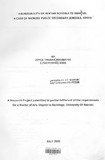| dc.description.abstract | This is an exploratory study on the vulnerability of Kenyan Schools to disasters.
As we enter a new century, our schools are likely to face formidable challenges
not previously encountered in our history as a nation. Technological and societal
conditions exist today, which pose significant risks to the safety of our schools.
In the recent past, the number of disaster situations in schools have escalated in
both number and complexity.
The general expectation by the parents, guardians and the society at large is
that the schools have both moral and legal obligations to provide a safe and
secure learning environment to those placed under their care. To meet the
obligations, the schools must be prepared to respond to any emergency
situation that may arise. Consequently, this exploratory study had the following
objectives: -
a) To identify and classify the types of hazards found in the schools in
Nairobi.
b) To study the extent to which secondary schools in Nairobi are vulnerable
to disaster.
c) To explore the relationship between the schools' administrative structures
and disasters.
d) To demonstrate the recovery strategies put in place in our schools to
cope with disaster situations.
The data was collected by use of structured questionnaires designed for
teachers in public secondary schools; in-depth interviews with school principals or their deputies and where possible, an observation checklist. The
questionnaires were administered on a "drop - and- pick - later" basis.
According to the findings of this study, it was evident that: -
1. There are various types of hazards existing within the school set up in
,
different proportions that expose them to disaster situations. In some
schools the magnitude of the hazards is higher than in others, implying
that some schools are more vulnerable than others.
2. Other factors, other than trust in expert systems, make schools
vulnerable to disasters. For example, lack of safety assessment on
buildings, exposed electricity wires, overcrowding in dormitories,
prefabricated buildings etc, all make schools vulnerable to disasters.
3. To some extent, the degree of exposure to disasters in schools is
influenced by the administrative framework of the school. For example,
lack of early warning systems to help control fire in its early stages; lack
of disaster preparedness plans; lack of fire drills and First Aid Kits; lack of
basic training on security; lack of fire extinguishers in key areas or lack of
emergency exits etc, expose schools to disasters.
4. Adequate strategies have not been put in place to cope with disaster ,
situations and schools are not prepared at all for disasters. To achieve
reasonable levels of minimization, it is necessary to reduce the adverse
effects of disasters through effective precautionary measures.
The study thus recommends that there be a national policy, formulated, by all the
stakeholders, that has clear strategies on how to prevent and control disasters. This
would be best achieved through joint workshops and seminars of parents, school
. administrators, relevant NGOs and the government. Further, the government should
adequately fund this effort, to enable schools' purchase the required equipments, materials and other facilities that would ensure disaster preparedness. The schools
should also employ security staff with comprehensive safety training capable of dealing
with any emergencies. It also recommends that every school should have an emergency
preparedness plan that is communicated to all the members of the school community. It
is also recommended that safety courses such as First Aid and fire-fighting training, be
made part of the school curriculum. Frequent courses, in-service and refresher courses
on safety assessment should be availed to the school principals and teachers. Finally, it
is recommended that the ministry of works performs safety assessment on school
buildings at least once every three years.
In addition, the study recommends that further research should be undertaken mainly
on those schools that have experienced major disasters in each province. The findings
would give invaluable insight on the specific causes of schools disasters. Such a
comparative study would help shed light on whether the causes of disasters in schools
are similar. The study further recommends that there is need to compare vulnerability of
public and private schools to disasters. This would help understand why there aren't
many cases of disasters in private schools. The study also proposes the need for action
research to enable the schools acquire the much required equipments, materials and
facilities that would ensure disaster preparedness. | en |

